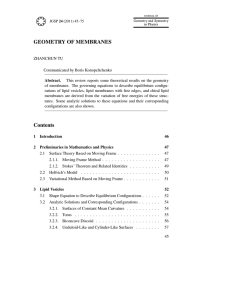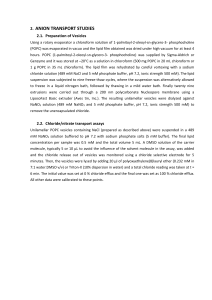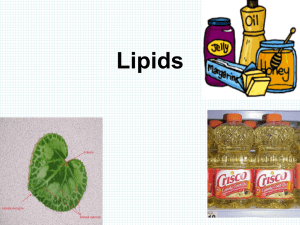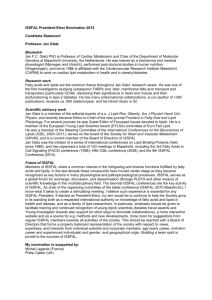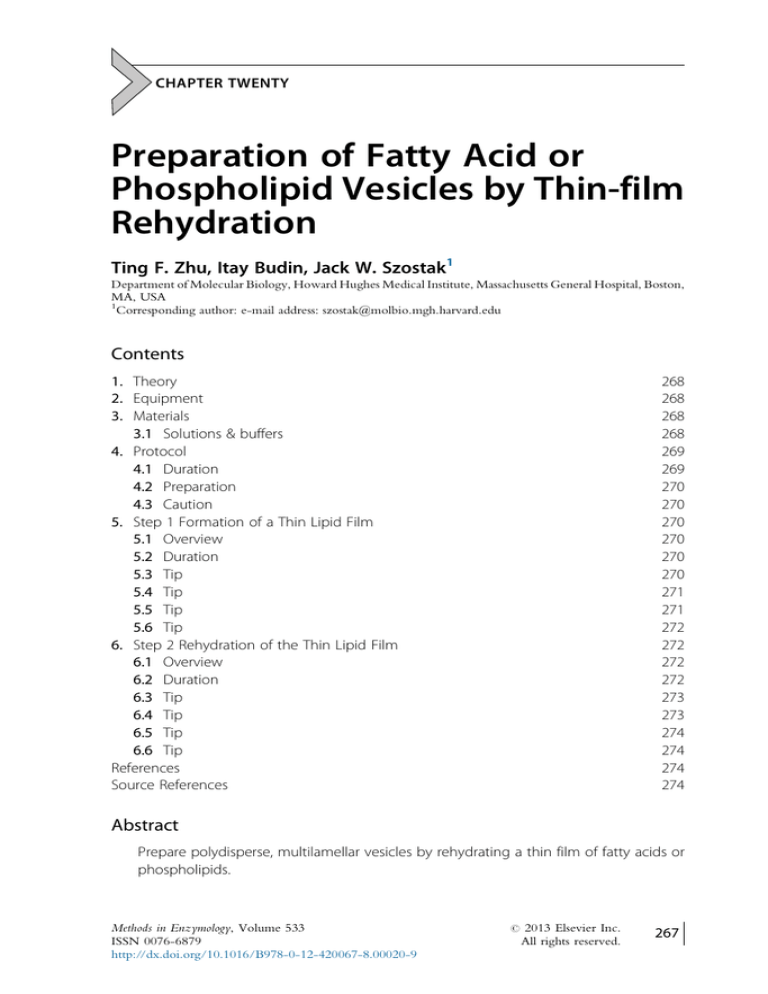
CHAPTER TWENTY
Preparation of Fatty Acid or
Phospholipid Vesicles by Thin-film
Rehydration
Ting F. Zhu, Itay Budin, Jack W. Szostak1
Department of Molecular Biology, Howard Hughes Medical Institute, Massachusetts General Hospital, Boston,
MA, USA
1
Corresponding author: e-mail address: szostak@molbio.mgh.harvard.edu
Contents
1. Theory
2. Equipment
3. Materials
3.1 Solutions & buffers
4. Protocol
4.1 Duration
4.2 Preparation
4.3 Caution
5. Step 1 Formation of a Thin Lipid Film
5.1 Overview
5.2 Duration
5.3 Tip
5.4 Tip
5.5 Tip
5.6 Tip
6. Step 2 Rehydration of the Thin Lipid Film
6.1 Overview
6.2 Duration
6.3 Tip
6.4 Tip
6.5 Tip
6.6 Tip
References
Source References
268
268
268
268
269
269
270
270
270
270
270
270
271
271
272
272
272
272
273
273
274
274
274
274
Abstract
Prepare polydisperse, multilamellar vesicles by rehydrating a thin film of fatty acids or
phospholipids.
Methods in Enzymology, Volume 533
ISSN 0076-6879
http://dx.doi.org/10.1016/B978-0-12-420067-8.00020-9
#
2013 Elsevier Inc.
All rights reserved.
267
268
Ting F. Zhu et al.
1. THEORY
The rehydration of a dry film of lipid(s) leads to the formation of vesicles. The lipid composition for the membranes can include phospholipids,
single-chain lipids (fatty acids, glycerol esters), sterols, or mixtures of various
amphiphiles. For fatty acid vesicles, the buffer pH should be near the pKa of
the bilayer-associated fatty acid (Cistola et al., 1988). The encapsulated contents of the vesicles are determined by the buffer used for the rehydration.
2. EQUIPMENT
Rotary evaporator
10-ml round-bottom glass flasks with cap
Benchtop rotary tumbler
Vortex mixer
pH meter
Glass pipettes
1.5-ml microcentrifuge tubes
3. MATERIALS
1-Palmitoyl-2-oleoyl-sn-glycero-3-phosphocholine (POPC)
Lissamine™
rhodamine
B
1,2-dihexadecanoyl-sn-glycero-3phosphoethanolamine (Rh-DHPE)
Oleic acid
Myristoleic acid
Glycerol monomyristoleate (GMM)
Bicine
8-Hydroxypyrene-1,3,6-trisulfonic acid trisodium salt (HPTS)
Sodium hydroxide (NaOH)
Chloroform
Methanol
Deionized water
3.1. Solutions & buffers
Preparation 20 mM POPC, 10 mM oleic acid in chloroform
Component
Stock
Amount
20 mM POPC in chloroform
20 mM
1 ml
Oleic acid
>99%
3.2 ml
269
Preparation of Fatty Acid or Phospholipid Vesicles by Thin-film Rehydration
10 mM oleic acid, 0.1 mM Rh-DHPE in chloroform
Component
Stock
Amount
Chloroform
1 ml
Oleic acid
>99%
3.2 ml
Rh-DHPE in chloroform
10 mM
10 ml
20 mM myristoleic acid, 10 mM glycerol monomyristoleate in chloroform (or use
methanol)
Component
Stock
Amount
Chloroform
1 ml
Myristoleic acid
>99%
5.6 ml
Glycerol monomyristoleate
>99%
2.8 ml
Step 2 Na-bicine buffer with HPTS, pH 8.5
Component
Final concentration
Stock
Amount
Na-bicine
200 mM
1M
1 ml
HPTS
2 mM
100 mM
0.1 ml
Add water to 5 ml
Na-bicine buffer, pH 8.5
Component
Final concentration
Stock
Amount
Na-bicine
200 mM
1M
1 ml
Add water to 5 ml
4. PROTOCOL
4.1. Duration
Preparation
About 10 min
Protocol
About 24 h
See Fig. 20.1 for an overview of the complete protocol.
270
Ting F. Zhu et al.
Figure 20.1 Flowchart of the complete protocol, including preparation.
4.2. Preparation
Prepare a solution containing the desired lipid composition for vesicles in a
nonpolar solvent (e.g., chloroform).
4.3. Caution
Work in a fume hood. All lipids should be stored at 20 C. Always use glass tips
for pipetting chloroform.
See Fig. 20.1 for the flowchart of the complete protocol.
5. STEP 1 FORMATION OF A THIN LIPID FILM
5.1. Overview
Evaporate a solution of lipids to form a thin layer of dry lipid film in a roundbottom flask.
5.2. Duration
30 min
1.1 Pipette the prepared solution of the desired lipids in a nonpolar solvent
into a 10-ml round-bottom flask. If fatty acid(s) are in the desired lipid
composition, pipette the appropriate amount of pure fatty acid into the
round-bottom flask first (see Fig. 20.2).
1.2 >Rotary evaporate the lipids in the round-bottom flask to completely
eliminate the chloroform in the sample (see Fig. 20.3). Alternatively,
dry the film under a stream of argon while manually rotating the flask
(see Fig. 20.4).
5.3. Tip
Clean the round-bottom flask with methanol before the procedure.
Preparation of Fatty Acid or Phospholipid Vesicles by Thin-film Rehydration
271
Figure 20.2 Pipette the prepared solution of the desired lipids in a nonpolar solvent
into the round-bottom flask.
Figure 20.3 Remove chloroform by rotary evaporation.
5.4. Tip
Avoid light by wrapping aluminum foil around the sample. Avoid oxygen by flushing
the container with argon or nitrogen gas.
5.5. Tip
To ensure that all solvent is removed from the film, leave the flask under vacuum for 1 h.
272
Ting F. Zhu et al.
Figure 20.4 Formation of a dry lipid film in a round-bottom flask.
5.6. Tip
If only fatty acids or glycerol esters are in the desired lipid composition, one can skip the
step of desolving fatty acids into chloroform, and instead directly add neat fatty acids or
glycerol esters to the buffer solution to make vesicles (Hanczyc et al., 2003).
6. STEP 2 REHYDRATION OF THE THIN LIPID FILM
6.1. Overview
Rehydrate the thin lipid film by adding buffer solution, leading to the formation of vesicles.
6.2. Duration
20 min
2.1 Add the prepared buffer solution to the round-bottom flask. Any solutes to be encapsulated in the vesicles should be included in the buffer.
2.2 Tightly cap the round-bottom flask, briefly vortex, and tumble for
10 min, until the thin lipid film at the bottom of the flask is completely
dispersed in the buffer (see Fig. 20.5).
2.3 Pipette the sample into a 1.5-ml microcentrifuge tube, vortex briefly,
and tumble overnight (see Fig. 20.6).
Preparation of Fatty Acid or Phospholipid Vesicles by Thin-film Rehydration
273
Figure 20.5 The thin lipid film (red) at the bottom of the flask is completely dispersed in
the buffer containing 2 mM HPTS (green).
Figure 20.6 Vesicle suspension in a 1.5-ml microcentrifuge tube, on a bench top rotary
tumbler.
6.3. Tip
Do not use borate or phosphate buffers, since they produce leaky fatty acid vesicles.
6.4. Tip
You can use a water-soluble fluorescent dye other than HPTS.
274
Ting F. Zhu et al.
6.5. Tip
Multiple cycles of freezing and thawing the vesicle sample may improve the encapsulation efficiency.
6.6. Tip
A thin film of phospholipid(s) does not dissolve well in a buffer solution without any
metal ions (e.g., ammonium acetate solution without Naþ). In this case, adding a
small amount of NaCl or NaOH helps to dissolve the lipid.
REFERENCES
Referenced Literature
Cistola, D. P., Hamilton, J. A., Jackson, D., & Small, D. M. (1988). Ionization and phase
behavior of fatty acids in water: Application of the Gibbs phase rule. Biochemistry, 27,
1881–1888.
Hanczyc, M. M., Fujikawa, S. M., & Szostak, J. W. (2003). Experimental models of primitive
cellular compartments: Encapsulation, growth, and division. Science, 302(5645),
618–622.
SOURCE REFERENCES
Chen, I. A., Roberts, R. W., & Szostak, J. W. (2004). The emergence of competition
between model protocells. Science, 305(5689), 1474–1476.
Zhu, T. F., & Szostak, J. W. (2009). Coupled growth and division of model protocell membranes. Journal of the American Chemical Society, 131(15), 5705–5713.

